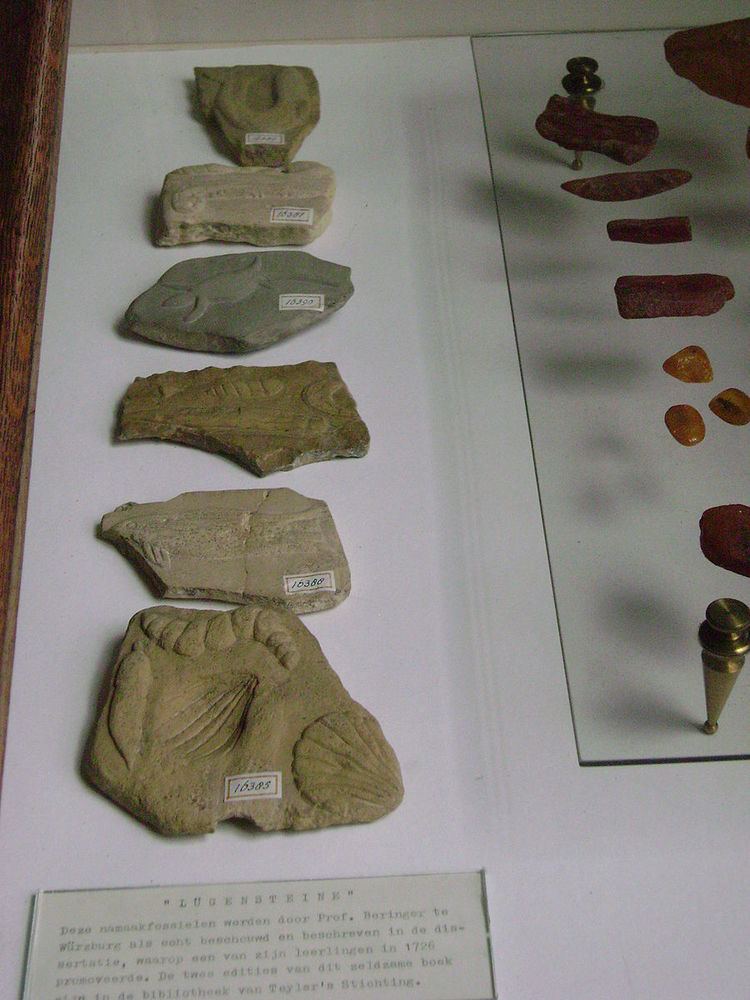 | ||
Beringer's Lying Stones (Lügensteine) are pieces of limestone carved into the shape of various animals, discovered in 1725 by Professor Johann Bartholomeus Adam Beringer, Dean of the Faculty of Medicine at the University of Würzburg. Beringer believed them to be fossils, and because some of them also bore the name of God in Hebrew, suggested that they might be of divine origin. In fact, he was the victim of a hoax, perpetrated on him by his colleagues ex-Jesuit J. Ignatz Roderick, Professor of Geography and Mathematics, and Johann Georg von Eckhart, privy counselor and university librarian. Upon discovering the truth, Beringer took his hoaxers to court, and the scandal that followed left all three of them in disgrace.
Some of the stones are now on display at the Oxford University Museum, and Teylers Museum in the Netherlands.
History
In 1725, the hoaxers carved fragments of limestone into the shapes of animals such as lizards, frogs, and spiders on their webs. To some of them, they added inscriptions such as the Hebrew name of God in Latin, Arabic, and Hebrew characters. They planted the stones on Mount Eibelstadt where Beringer frequently went to search for fossils.
The mechanism by which fossils were formed was not known at the time, and so despite the fantastical nature of these fakes Beringer took them seriously and published a book describing them (Lithographiæ Wirceburgensis, 1726). Beringer proposed several possible explanations for the supposed fossils, in addition to his own preferred interpretation that while some few of these stones might be dead animals (fossils), most were just "capricious fabrications of God". He also considered the possibility that they were the carvings of prehistoric pagans, but he had to rule this out since pagans had no knowledge of the name of God.
Even before publication of Beringer's book, critics had pointed out that some of the stones showed evidence of chisel marks. Beringer had noticed this too, and said in his book:
...the figures...are so exactly fitted to the dimensions of the stones, that one would swear that they are the work of a very meticulous sculptor...[and they] seem to bear unmistakable indications of the sculptor's knife... One would swear that he discerned in many of them the strokes of a knife gone awry, and superfluous gouges in several directions.
However, this evidence of sculpting only convinced him more strongly that the chisel was wielded by the hand of God.
Roderick and Eckart continued planting progressively more outrageous fakes, but eventually decided that the hoax was getting out of hand and tried to convince Beringer that the stones were a fraud without admitting that they were the hoaxers. Beringer rejected their attempt, writing of "two men, perhaps best described as a pair of antagonists who tried to discredit the stones". Beringer brought Eckert and Roderick to court, to "save his honor". Some of the court transcript still exists, and in the testimony the hoaxers make clear that they did indeed want to discredit Beringer, because, they said, "he was so arrogant and despised us all".
The scandal not only discredited Beringer, it ruined the reputations of Eckart and Roderick. Roderick had to leave Würzburg. Eckart lost his post and privileges to use the library and archives. This hampered his own historical research, which was left unfinished at his death. The stones became known as Lügensteine, or "lying stones". Some of the stones have survived to the present.
After his death in 1740, a second printing of his book was produced in 1767. In 1963, it was translated into English.
